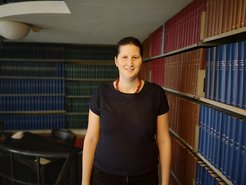Michelle Frei honored with EDCH Doctoral Program Thesis Distinction Top 8%
The award highlights scientific excellence of the candidates
Michelle Frei, former PhD student of Kai Johnsson in the Department of Chemical Biology at the MPIMR in Heidelberg, was granted the Distinction Top 8% of EDCH Doctoral Program Thesis. The program for chemistry and chemical engineering at EPFL honors very high quality theses once a year to highlight scientific excellence of their candidates.
Michelle Frei was granted the Distinction Top 8% of EDCH Doctoral Program for her thesis on “Photoactivatable Silicon Rhodamines for Super-Resolution Microscopy”. She is a former PhD student of Kai Johnsson in the Department of Chemical Biology at the Max Planck Institute for Medical Research in Heidelberg who currently continues her work in the department as a postdoc. The program for chemistry and chemical engineering (EDCH) at EPFL honors very high quality theses once a year to highlight the scientific excellence of their candidates.

“I am honored to receive this prize by EPFL’s Doctoral Program in Chemistry and Chemical Engineering acknowledging my doctoral thesis work. I would like to thank my supervisor Kai Johansson as well as the members of my PhD defence jury committee Professor Pablo Rivera-Fuentes, Professor Stefan Matile, Dr. Stefan Pitsch, and the jury president Professor Beat Fierz for taking the time to review my thesis work and all their suggestions and inputs”, says Michelle Frei.
Her thesis in a nutshell:
Michelle Frei’s main focus was the development of small-molecule fluorescent dyes that can be turned on by light for advanced fluorescence microscopy. She synthesized various analogues and characterized them chemically and spectroscopically. A central piece of her work was to investigate new mechanism of photoactivation to diversify the palette of available concepts. Rigorous analysis of the fluorophore’s equilibrium system allowed Frei to generate probes with minimal background fluorescence, which were successfully implemented in super-resolution microscopy experiments of living cells. More recently, she investigated how protein surfaces affect fluorophore brightness when small-molecule dyes are bound to self-labeling protein tags. Introduction of mutations at the fluorophore-protein interface coupled with structural analysis of co-crystal structures allowed her to understand and improve the fluorescence turn-on upon fluorophore binding.
